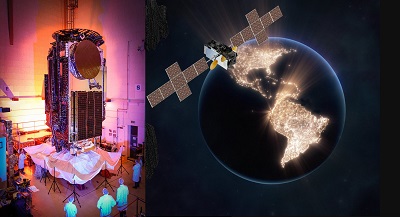New York, (Asian independent) The world’s largest private communications satellite Jupiter 3 is all set for launch on Wednesday, the company announced.
Hughes Network Systems’ Jupiter 3 built by Maxar Technologies is an ultra high-density satellite that will be launched aboard SpaceX’s Falcon Heavy rocket at 11.04 p.m. on Wednesday (8.34 a.m. IST on Thursday) from Cape Canaveral in Florida.
The powerful geostationary satellite will be positioned 22,300 miles above the Earth’s equator. Jupiter 3 is engineered to deliver gigabytes of connectivity to customers across North and South America.
“When fully deployed, Jupiter 3, the largest commercial communications satellite ever built, approaches the wingspan of a commercial airliner,” the company said in a statement.
“We’re launching a new era of connectivity with <https://twitter.com/hashtag/JUPITER3?src=hashtag_click>Jupiter 3!” the company wrote on Twitter.
Jupiter 3 will double the capacity of the Hughes Jupiter satellite fleet. It will also support in-flight Wi-Fi, maritime connections, enterprise networks, backhaul for Mobile Network Operators (MNOs), and Community Wi-Fi solutions, in addition to satellite internet connectivity across North and South America.
The powerful satellite has about 14 high-powered solar panels that will collect the sun’s energy to power Jupiter 3 for its entire lifetime (about 15 years).
With 7 panels on each side, the arrays measure 127 feet end to end when deployed –that’s bigger than a blue whale, the largest animal on the planet.
Meanwhile, SpaceX said its team is ready to launch the rocket.
“Teams completed the launch readiness review, and we are targeting Wednesday…for the satellite from Launch Complex 39A in Florida,” the Elon Musk-led company wrote on Twitter.
The company’s Falcon Heavy mounted with 27 Merlin rocket engines are capable of producing over 5 million pounds force (22,241 kilonewtons) of thrust at liftoff, and can launch almost 27,215 kg to geosynchronous orbit.
For the Jupiter 3 mission, the rocket’s two side boosters are expected to perform boost-back burns to return to SpaceX’s Landing Zones 1 and 2 at Cape Canaveral, approximately 8 or 9 minutes after launch.
The core booster, however, will not attempt a sea landing on one of SpaceX’s autonomous drone ships, as is typical for Falcon 9 and Falcon Heavy launches.
Instead, the core stage will use its fuel reserves to place the hefty Jupiter 3 in its proper orbit.








